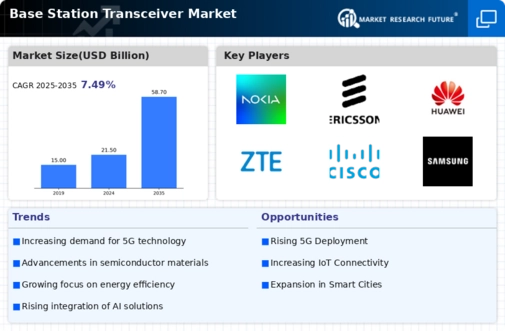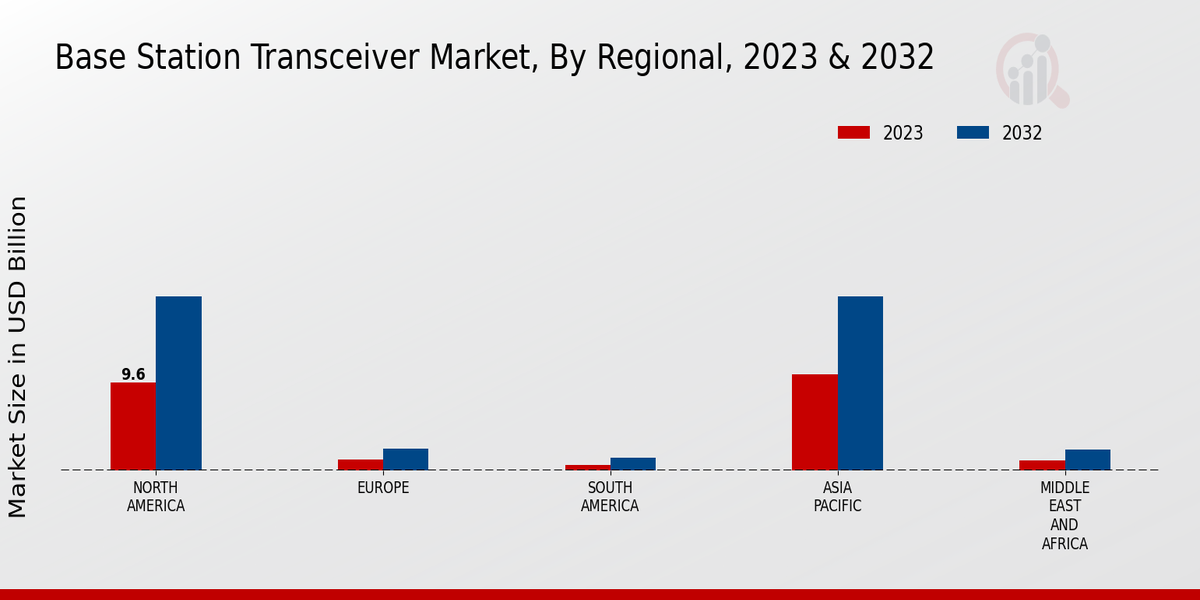Advancements in 5G Technology
The Global Base Station Transceiver Market Industry is significantly influenced by advancements in 5G technology, which promises enhanced speed and connectivity. As nations invest in 5G infrastructure, the demand for sophisticated base station transceivers escalates. These devices are essential for enabling the high-frequency bands utilized in 5G networks. The transition to 5G is expected to propel the market to a valuation of 58.7 USD Billion by 2035, indicating a robust growth trajectory. Furthermore, the anticipated compound annual growth rate (CAGR) of 9.55% from 2025 to 2035 underscores the potential for innovation and investment in this sector, as companies strive to meet the evolving needs of consumers and industries alike.
Growing Adoption of Smart Cities
The concept of smart cities is gaining traction globally, which significantly impacts the Global Base Station Transceiver Market Industry. Smart cities rely on interconnected devices and systems to enhance urban living, necessitating robust communication networks. Base station transceivers are integral to supporting the infrastructure required for smart city applications, such as traffic management, public safety, and environmental monitoring. As urbanization continues to rise, the demand for efficient communication solutions will likely increase. This trend suggests a promising outlook for the market, as investments in smart city projects drive the need for advanced base station transceivers to facilitate seamless connectivity.
Increased Government Initiatives
Government initiatives aimed at enhancing telecommunications infrastructure play a pivotal role in the Global Base Station Transceiver Market Industry. Various countries are implementing policies to promote the deployment of advanced communication networks, particularly in rural and underserved areas. These initiatives often include funding and regulatory support, which facilitate the installation of base station transceivers. As governments prioritize digital inclusion and connectivity, the market is likely to benefit from increased investments. This trend not only fosters economic growth but also ensures that a broader segment of the population gains access to reliable communication services, thereby driving demand for base station transceivers.
Emerging Markets and Urbanization
Emerging markets are witnessing rapid urbanization, which presents a significant opportunity for the Global Base Station Transceiver Market Industry. As populations migrate to urban areas, the demand for reliable communication infrastructure intensifies. Countries in Asia and Africa, in particular, are experiencing substantial growth in mobile subscriptions, necessitating the deployment of base station transceivers to accommodate this influx. The expansion of mobile networks in these regions is expected to contribute to the overall market growth, as urban centers require enhanced connectivity to support economic activities. This trend highlights the potential for investment and development in base station transceiver technologies to meet the needs of burgeoning urban populations.
Rising Demand for Mobile Connectivity
The Global Base Station Transceiver Market Industry experiences a surge in demand for mobile connectivity, driven by the proliferation of smartphones and IoT devices. As of 2024, the market is valued at approximately 21.5 USD Billion, reflecting the increasing reliance on mobile networks for communication and data transfer. This trend is likely to continue as consumers and businesses seek faster and more reliable connections. The expansion of 5G technology further amplifies this demand, necessitating advanced base station transceivers to support higher data rates and lower latency. Consequently, the industry is poised for growth as mobile connectivity becomes a fundamental aspect of daily life.



 Source: Primary Research, Secondary Research, MRFR Database and Analyst Review
Source: Primary Research, Secondary Research, MRFR Database and Analyst Review



















Leave a Comment